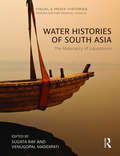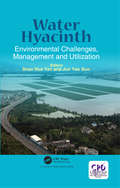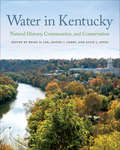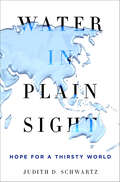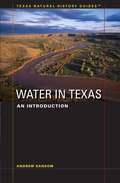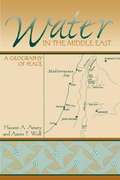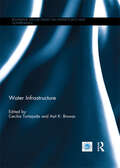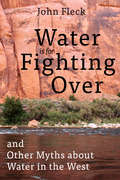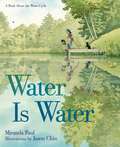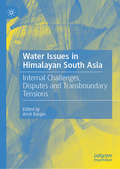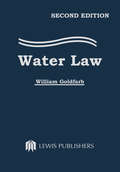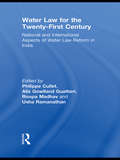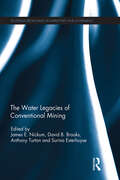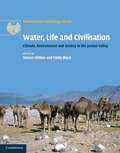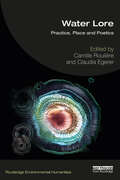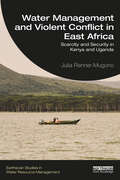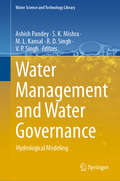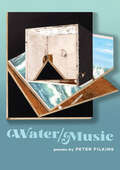- Table View
- List View
Water Histories of South Asia: The Materiality of Liquescence (Visual and Media Histories)
by Sugata Ray Venugopal MaddipatiThis book surveys the intersections between water systems and the phenomenology of visual cultures in early modern, colonial and contemporary South Asia. Bringing together contributions by eminent artists, architects, curators and scholars who explore the connections between the environmental and the cultural, the volume situates water in an expansive relational domain. It covers disciplines as diverse as literary studies, environmental humanities, sustainable design, urban planning and media studies. The chapters explore the ways in which material cultures of water generate technological and aesthetic acts of envisioning geographies, and make an intervention within political, social and cultural discourses. A critical interjection in the sociologies of water in the subcontinent, the book brings art history into conversation with current debates on climate change by examining water’s artistic, architectural, engineering, religious, scientific and environmental facets from the 16th century to the present. This is one of the first books on South Asia’s art, architecture and visual history to interweave the ecological with the aesthetic under the emerging field of eco art history. The volume will be of interest to scholars and general readers of art history, Islamic studies, South Asian studies, urban studies, architecture, geography, history and environmental studies. It will also appeal to activists, curators, art critics and those interested in water management.
Water Hyacinth: Environmental Challenges, Management and Utilization
by Shaohua Yan Jun Yao GuoThe water hyacinth is a disruptive factor in aquatic ecosystem management and ecosystem services, and causes problems in fisheries, transportation waterways, irrigation, hydropower generation, and water resources. To address these concerns, it is necessary to integrate past studies with current research and innovations to identify where the knowledge gap is and to creatively assess and solve the problems in a global context. This book provides comprehensive coverage of new research and technological innovations for the application of controlling, managing, harvesting, postharvest processing and utilizing the water hyacinth.
Water in Biological and Chemical Processes
by Biman BagchiBuilding up from microscopic basics to observed complex functions, this insightful monograph explains and describes how the unique molecular properties of water give rise to its structural and dynamical behaviour which in turn translates into its role in biological and chemical processes. The discussion of the biological functions of water details not only the stabilising effect of water in proteins and DNA, but also the direct role that water molecules themselves play in biochemical processes, such as enzyme kinetics, protein synthesis and drug-DNA interaction. The overview of the behaviour of water in chemical systems discusses hydrophilic, hydrophobic and amphiphilic effects, as well as the interactions of water with micelles, reverse micelles, microemulsions and carbon nanotubes. Supported by extensive experimental and computer simulation data, highlighting many of the recent advances in the study of water in complex systems, this is an ideal resource for anyone studying water at the molecular level.
Water in Kentucky: Natural History, Communities, and Conservation
by Brian D. Lee, Daniel I. Carey, And Alice L. JonesTwenty-three essays examining the biophysical and the historical and contemporary stories of water&’s impact on communities throughout Kentucky. Home to sprawling Appalachian forests, rolling prairies, and the longest cave system in the world, Kentucky is among the most ecologically diverse states in the nation. Lakes, rivers, and springs have shaped and nourished life in the Commonwealth for centuries, and water has played a pivotal role in determining Kentucky&’s physical, cultural, and economic landscapes. The management and preservation of this precious natural resource remain a priority for the state&’s government and citizens. In this generously illustrated book, experts from a variety of fields explain how water has defined regions across the Commonwealth. Together, they illuminate the ways in which this resource has affected the lives of Kentuckians since the state&’s settlement, exploring the complex relationship among humans, landscapes, and waterways. They examine topics such as water quality, erosion and sediment control, and emerging water management approaches. Through detailed analysis and case studies, the contributors offer scholars, practitioners, policy makers, and general readers a wide perspective on the state's valuable water resources.Praise for Water in Kentucky &“Simply outstanding! Water in Kentucky offers an exciting close-up view of what happens to the water that falls on the Commonwealth. You&’ll be fascinated by the many innovative projects your neighbors are implementing to clean polluted runoff and to restore attractive wetlands and streams. This volume will guide you in taking action to improve water quality in your community for the benefit of people, plants, and wildlife.&” ―Thomas R. Biebighauser, author of Wetland Drainage, Restoration, and Repair &“This collection of 23 essays expertly covers the intricate relationship between water and our daily lives. These essays could easily serve as springboards for conversation in conservation and policy implementation for the future. This book stands as an important addition to the study of water resources in Kentucky.&” ―Kentucky Libraries &“A labor of love and a remarkable example of persistence and commitment by its editors Brian D. Lee, Daniel I. Carey, and Alice L. Jones, and a wide variety of invited contributors. This book goes a long way toward weaving together many perspectives to create a better overall picture of the relevance of water in Kentucky.&” ―Groundwater
Water in Plain Sight: Hope for a Thirsty World
by Judith D. SchwartzWater scarcity is on everyone's mind. Long taken for granted, water availability has entered the realm of economics, politics, and people's food and lifestyle choices. But as anxiety mounts - even as a swath of California farmland has been left fallow and extremist groups worldwide exploit the desperation of people losing livelihoods to desertification - many are finding new routes to water security with key implications for food access, economic resilience, and climate change.Water does not perish, nor require millions of years to form as do fossil fuels. However, water is always on the move. In this timely, important book, Judith D. Schwartz presents a refreshing perspective on water that transcends zero-sum thinking. By allying with the water cycle, we can revive lush, productive landscapes. Like the river in rural Zimbabwe that, thanks to restorative grazing, now flows miles further than in living memory. Or the food forest of oranges, pomegranates, and native fruit-bearing plants in Tucson, grown through harvesting urban wastewater. Or the mini-oasis in West Texas nourished by dew.Animated by stories from around the globe, Water In Plain Sight is an inspiring reminder that fixing the future of our drying planet involves understanding what makes natural systems thrive.
Water in Texas: An Introduction
by Andrew SansomNo natural resource issue has greater significance for the future of Texas than water. The state's demand for water for municipal, industrial, agricultural, and recreational uses continues to grow exponentially, while the supply from rivers, lakes, aquifers, and reservoirs is limited. To help Texans manage their water resources today and plan for future needs, one of Texas's top water experts has compiled this authoritative overview of water issues in Texas.<P><P>
Water in the Middle East: A Geography of Peace
by Hussein A. Amery Aaron T. WolfFinding "streams in the desert" has never been more urgent for the peoples of the Middle East. Rapid population growth and a rising standard of living are driving water demand inexorably upward, while the natural supply has not increased since Biblical times. Ensuring a fair and adequate distribution of water in the region is vitally important for building a lasting peace among the nations of the Middle East.
Water Infrastructure (Routledge Special Issues on Water Policy and Governance)
by Cecilia Tortajada and Asit K. BiswasWater infrastructure is an essential element in water management. Together with institutions, policies and regulation, it provides basic services to growing populations, especially in developing countries, where much of the growth is taking place. In the Asia-Pacific region, for instance, populations are growing not only in size but also in affluence, straining further the existing infrastructure and demanding urgently the development of a new one. While 79% of total water use in Asia occurs in agriculture, the fastest increases in demand are emanating from industry and from urban areas. This trend is a natural consequence of the fastest industrialization and urbanization process in history. By 2030, more than 55% of Asia’s population will live in urban areas, an increase of 1.1 billion people. Nevertheless, water infrastructure is of concern not only in the global South but also in the North, where much of the drinking-water infrastructure needs upgrading or replacement, a significant undertaking as infrastructure is more than a hundred years old in many cases. The American Water Works Association estimates that changing all of the water pipes in the United States would cost more than USD 1 trillion. In this book, in-depth case studies on water infrastructure challenges and policy solutions are presented from different parts of the world.This book was published as a special issue of the International Journal of Water Resources Development.
Water Insecurity and Water Governance in Urban Kenya: Policy and Practice (Global Challenges in Water Governance)
by Anindita SarkarThis book explores water service provisions of the urban poor in the cities of Africa with particular emphasis on Kenya and its capital city of Nairobi. In particular the book addresses the insecurity of tenure, and how the colonial segregation of land continues to shape water access and service provision even today in Nairobi. The book seeks to understand how urban water management entails the “production of thirst” among the urban poor and documents how cultural norms, political commitments and seemingly mundane practices of water managers combine to exclude the poor from accessing water. Supporters of privatization argue that private companies may succeed where governments have failed in supplying water to the urban poor. The author takes a closer look at this argument, demonstrating the limitations of some of the current reforms whilst also exploring alternatives and solutions. This book will be an invaluable reference for students, researchers and practitioners working in this field.
Water is for Fighting Over: and Other Myths about Water in the West
by John FleckWhen we think of water in the West, we think of conflict and crisis. In recent years, newspaper headlines have screamed,"Scarce water and the death of California farms," "The Dust Bowl returns," "A 'megadrought' will grip U.S. in thecoming decades." Yet similar stories have been appearing for decades and the taps continue to flow. John Fleck arguesthat the talk of impending doom is not only untrue, but dangerous. When people get scared, they fight for the last drop ofwater; but when they actually have less, they use less.Having covered environmental issues in the West for a quarter century, Fleck would be the last writer to discount theserious problems posed by a dwindling Colorado River. But in that time, Fleck has also seen people in the Colorado RiverBasin come together, conserve, and share the water that is available. Western communities, whether farmers and city-dwellers or US environmentalists and Mexican water managers, have a promising record of cooperation, a recordoften obscured by the crisis narrative.In this fresh take on western water, Fleck brings to light the true history of collaboration and examines the bondscurrently being forged to solve the Basin's most dire threats. Rather than perpetuate the myth "Whiskey's for drinkin', water's for fightin' over," Fleck urges readers to embrace a new, more optimistic narrative--a future where the Colorado continues to flow.
Water is Water: A Book about the Water Cycle
by Miranda Paul Jason ChinThis spare, poetic picture book follows a group of kids as they move through all the different phases of the water cycle. From rain to fog to snow to mist, talented author Miranda Paul and the always remarkable Jason Chin (Redwoods, Coral Reefs, Island, Gravity) combine to create a beautiful and informative journey in this innovative nonfiction picture book that will leave you thirsty for more.
Water Issues in Himalayan South Asia: Internal Challenges, Disputes and Transboundary Tensions
by Amit RanjanThe book looks into the domestic water issues and disputes in the Himalayan South Asian countries, and based on it analyzes trans-boundary water disputes. Himalayan South Asia comprises India, Pakistan, Bangladesh, Nepal, Bhutan, and Afghanistan. All except Afghanistan share river waters with India. Home to some of the major river basins of the world, a part of this region falls into water scarce zone, and according to the United Nations Water Report of 2018 some of them will experience severe water scarcity by 2050.The book also studies water issues in China. Though the country is not a part of the Himalayan South Asia, most of the major rivers of this region originate in China. Over the years, China has been alleged by countries like India for diverting, choking or using the trans-boundary river waters for its purpose. Understanding water competition and issues in China will help one to understand its transboundary water behavior.
Water Justice and Groundwater Subsidies in India: Equitable and Sustainable Access and Regulation (Earthscan Studies in Water Resource Management)
by Gayathri D. NaikThis book examines the impact of water-related subsidies on social and distributive equity and environmental sustainability in groundwater access and regulation in India.This book argues that adopting a water justice framework is essential to ensure equitable and sustainable access to and regulation of groundwater by balancing anthropogenic and ecological water needs. The inherent inequity resulting from property rights-controlled groundwater access gets widened by the social, political, and economic factors determining the subsidy beneficiaries. Adopting a socio-legal approach, this book draws on two contrasting case studies in India: Kerala, a water-secure state, and Rajasthan, an arid state. Arguing for a shift to a new paradigm in water governance, it critically examines the feasibility of the public trust doctrine and rights of nature discourse to analyse the best suitable regulatory framework that can balance the human right to water and ecological sustainability in groundwater resources. It demonstrates the feasibility of adopting various environmental law principles that balance human rights to water and nature. It argues that the hitherto highlighted public trust doctrine cannot address these inequities due to its anthropogenic bias and property rights link. This book examines the applicability of the rights of nature discourse instead of these property rights-based regulations to incorporate and mainstream the concerns of aquifer protection in water governance.This book shall be of great interest to students, scholars, and practitioners of water law and policy, environmental law, water and social justice, development studies, and political ecology.
Water Law
by William GoldfarbThis revised second edition is essential to everyone involved with water and water resources-complying with the myriad federal, state, and local laws and regulations that govern the use and management of water in our attempts to maintain, clean, usable water. It includes the law of water diversion and distribution; water resources development and protection; water treatment and land use; ocean dumping; oil and hazardous substances cleanup; riparian and non-riparian systems; Eastern permit systems; beneficial use; water codes; prior appropriation; surface and ground water; channel modifications; municipal water supply; irrigation; California Water Management Districts; Bureau of Reclamation; Corps of Engineers; Water Resources Development Act of 1986; SCS, TVA, BPA, NEA, CERCLA, CWA, SDWA, RCRA, and their substantial changes in the last four years; water resources planning and research; public use; ownership of beds and banks; wild and scenic rivers; river corridor and instream flow protection; flood insurance, Section 404 and Section 208; the Supreme Court and water conservation; heat dischargers; quality-based effluent limitations; state ground water programs; pretreatment; funding; enforcement; citizen suits; and many more vital topics.
Water Law for the Twenty-First Century: National and International Aspects of Water Law Reform in India
by Philippe Cullet Alix Gowlland-Gualtieri Roopa Madhav Usha RamanathanIn the face of growing freshwater scarcity, most countries of the world are taking steps to conserve their water and foster its sustainable use. Water crises range from concerns of drinking water availability and/or quality, the degradation or contamination of freshwater, and the allocation of water to different users. To meet the challenge, many countries are undergoing systemic changes to the use of freshwater and the provision of water services, thereby leading to greater commercialization of the resource as well as a restructuring of the legal, regulatory, technical and institutional frameworks for water. The contributions to this book critically analyse legal issues arising under international law, such as environment and human rights provisions, concerning the economic, environmental and social consequences of proposed water regulatory changes and their implementation at the national level. The book examines the situation in India which is currently in the midst of implementing several World Bank led water restructuring projects which will have significant impacts on the realisation of the right to water and all other aspects of water regulation for decades to come. In analysing the situation in India the volume is able to detail the interactions between international law and national law in the field of water, and to ask broader questions about the compliance with international law at the national level and the relevance of international law in national law and policy-making.
Water Law, Policy and Economics in Italy: Between National Autonomy and EU Law Constraints (Global Issues in Water Policy #28)
by Paolo Turrini Antonio Massarutto Marco Pertile Alessandro De CarliThis book provides the first comprehensive overview of the most important water-related issues that centre on Italy, analysed from several disciplinary perspectives – such as hydrology, economics, law, sociology, environmental sciences and policy studies – in order to promote full understanding of the challenges the country is facing and the ways it could best tackle them.Despite the misconception that Italy is a water-scarce country, is in fact quite rich in water resources. Such resources, however, are unevenly distributed over the Italian territory. Italy’s northern regions rely on quite an abundant quantity of freshwater, whereas in the southern area water endowment is limited. Moreover, climatic differences between North and South contribute to widen the divide. This disparity has notable consequences of socio-economic character, some of which, in turn, feed back into the environmental conditions of Italian regions: pollution, floods, landslides and droughts are among the problems affecting the country. There are numerous features of water use and consumption that distinguish Italy from other comparable countries, such as the significant role played by agriculture (a water-intensive activity), a lead position in the consumption of bottled water, lower-than-average prices of water and a far-from-optimal efficiency of waterworks. All such aspects, and many others, make Italy an essential case study.
The Water Legacies of Conventional Mining (Routledge Special Issues on Water Policy and Governance)
by James E. Nickum David B. Brooks Anthony Turton Surina EsterhuyseThe impact of mining is too big to ignore in a world of oversubscribed water. This is true of conventional mining as much as – or even more than – hydraulic fracturing (fracking). The legacy issues of such mining on water have not been fully appreciated, especially the irretrievable effects mining has had on communities and ecosystems around the world through its impact on water. Yet this is not an ‘us-or-them’ problem: the wealth, influence and technical knowledge of mining interests can and must be part of the solution. All of the contributions to this volume either consider the deficiencies of existing governance structures and the need for better ones, or explore the use of new techniques to identify and evaluate social and environmental impacts. The chapters in this book were originally published in the journal Water International.
Water, Life and Civilisation
by Emily Black Steven MithenA unique interdisciplinary study of the relationships between climate, hydrology and human society from 20,000 years ago to the present day within the Jordan Valley. It describes how state-of-the-art models can simulate the past, present and future climates of the Near East, reviews and provides new evidence for environmental change from geological deposits, builds hydrological models for the River Jordan and associated wadis and explains how present day urban and rural communities manage their water supply. The volume provides a new approach and new methods that can be applied for exploring the relationships between climate, hydrology and human society in arid and semi-arid regions throughout the world. It is an invaluable reference for researchers and advanced students concerned with the impacts of climate change and hydrology on human society, especially in the Near East.
Water Lore: Practice, Place and Poetics (Routledge Environmental Humanities)
by Camille Roulière Claudia EgererLocated within the field of environmental humanities, this volume engages with one of the most pressing contemporary environmental challenges of our time: how can we shift our understanding and realign what water means to us? Water is increasingly at the centre of scientific and public debates about climate change. In these debates, rising sea levels compete against desertification; hurricanes and floods follow periods of prolonged drought. As we continue to pollute, canalise and desalinate waters, the ambiguous nature of our relationship with these entities becomes visible. From the paradisiac and pristine scenery of holiday postcards through to the devastated landscapes of post-tsunami news reports, images of waters surround us. And while we continue to damage what most sustains us, collective precarity grows. Breaking down disciplinary boundaries, with contributions from scholars in the visual arts, history, earth systems, anthropology, architecture, literature and creative writing, archaeology and music, this edited collection creates space for less-prominent perspectives, with many authors coming from female, Indigenous and LGBTQIA+ contexts. Combining established and emerging voices, and practice-led research and critical scholarship, the book explores water across its scientific, symbolic, material, imaginary, practical and aesthetic dimensions. It examines and interrogates our cultural construction and representation of water and, through original research and theory, suggests ways in which we can reframe the dialogue to create a better relationship with water sources in diverse contexts and geographies. This expansive book brings together key emerging scholarship on water persona and agency and would be an ideal supplementary text for discussions on the blue humanities, climate change, environmental anthropology and environmental history.
Water Management and Violent Conflict in East Africa: Scarcity and Security in Kenya and Uganda (Earthscan Studies in Water Resource Management)
by Julia Renner-MugonoThis book examines the complex interrelationships between water availability, governance and violent and non-violent conflicts, drawing on in-depth case studies of Lake Naivasha in Kenya and Lake Wamala in Uganda. When international economic endeavours like flower farming, oil exploration and extensive rice growing are coupled with a government's prioritization of economic development, not only does this lead to the commercialization of water resources but it also creates conflicts between national, regional and local stakeholders. Often overlooked in existing literature, such is the case even in water abundant areas like Lake Naivasha and Lake Wamala. Presenting a comparative study, the book provides a unique perspective on multifunctional water use and illustrates how politically and economically motivated water use increases violent tensions over access to and the use of freshwater resources. The coverage stretches from international and national agencies to NGOs, economic stakeholders and local actors. The book evaluates the resilience and vulnerability of local actors' ability to access water and examines the nexus between the need to access water and the ability to influence access to water, taking into consideration both countries’ economic development agendas. The book concludes by discussing strategies for reducing water-induced conflicts that can be applied to not only these cases but water conflicts across the globe. This book will be of great interest to scholars and professionals of water resource management and governance, African development, conflict resolution and sustainable development.
Water Management and Water Governance: Hydrological Modeling (Water Science and Technology Library #96)
by Ashish Pandey S. K. Mishra M. L. Kansal R. D. Singh V. P. SinghThis book focusses on hydrological modeling, water management, and water governance. It covers the applications of remote sensing and GIS tools and techniques for land use and land cover classifications, estimation of precipitation, evaluation of morphological changes, and monitoring of soil moisture variability. Moreover, remote sensing and GIS techniques have been applied for crop mapping to assess cropping patterns, computation of reference crop evapotranspiration, and crop coefficient. Hydrological modeling studies have been carried out to address various issues in the water sector. MODFLOW model was successfully applied for groundwater modeling and groundwater recharge estimation. Runoff modeling has been carried out to simulate the snowmelt runoff together with the rainfall and sub-surface flow contributions for snow-fed basins. A study has been included, which predicts the impact of the land use and land cover on stream flow. Various problems in the water sector have been addressed employing hydrological models such as SWAT, ArcSWAT, and VIC. An experimental study has been presented wherein the laboratory performance of rainfall simulator has been evaluated. Hydrological modeling studies involving modifications in the curve number methodology for simulation of floods and sediment load have also been presented. This book is useful for academicians, water practitioners, scientists, water managers, environmentalists, and administrators, NGOs, researchers, and students who are involved in water management with the focus on hydrological modeling, water management, and water governance.
Water Management in China’s Power Sector (Earthscan Studies in Water Resource Management)
by Xiawei Liao Jim W. HallThis book examines water resource management in China’s electric power sector and the implications for energy provision in the face of an emerging national water crisis and global climate change. Over 75% of China’s current electricity comes from coal. Coal-fired power plants are reliant on water, with plants using significant volumes of water every year, yet water resources are unevenly distributed. In the face of serious environmental concerns and increasing electricity demand, this book examines the environmental impacts that coal power plants have on water resources and the impact water availability has on the electricity sector in a country with a significant number of water-scarce provinces and a large number of power plants located on inland waterways. It discusses the water impacts and constraints for transforming the electric power sector away from coal to renewable energy sources, such as hydropower and concentrated solar power. The book adopts a mix-method approach, combining a plant-level quantitative analysis on water impacts and dependencies in China’s electricity sector and a qualitative analysis of relevant institutions in both sectors. By reviewing policy and institution cases in China’s water and electricity sectors, the book provides important recommendations calling for coordinated institutions to shift away from the current paradigm where water and electricity are governed independently. Enriching the water-energy nexus literature, this book will be of great interest to students and scholars working on water resource management, energy industries and Chinese environmental policy, as well as policymakers and practitioners in those fields.
Water Management in Italy
by Andrea Guerrini Giulia RomanoThis book describes the water sector as it is structured in Italy. The first part describes the legal framework which rules the sector in Italy, its evolution since the last 20 years, and its weaknesses. The second part describes the governance of Italian water utilities, distinguishing full public-owned companies from public-private partnership and private companies. The third part reports insights on water utilities performance to enquire the presence of economies by scope, scale and density in the Italian water sector, and to verify the presence of any differences in terms of efficiency and tariffs among public and private firms. The fourth part describes the investment policies carried out by water utilities, observing the total amount of per capita investments and the actual realization of planned investments. The fifth part describes if and how utilities applied water conservation practices to incentive the sustainable water use.
Water Markets for the 21st Century
by K. William Easter Qiuqiong HuangThis book evaluates the history, the present and the future of water markets on 5 continents, beginning with the institutional underpinnings of water markets and factors influencing transaction costs. The book examines markets in seven countries and three different U. S. states, ranging from village-level water markets in Oman to basin wide formal water markets in Australia's Murray-Darling River basin. Introductory chapters on the background of water markets and on transaction costs and policy design are followed by chapter length discussion of water markets as an adaptive response to climate change and of supply reliability in a changing climate. Case studies describe a variety of facets of the design and function of markets around the world: California, Chile, Spain, Oman, Australia, Canada, India and China. In analyzing these real-world examples of markets, the contributors explore water rights and trading of rights between agricultural and urban sectors and the principles and function of option markets. They discuss different sized approaches, from large scale, ministry-level administration of markets to informal arrangements among farmers in the same village, or groups of villages which allocate water without large investment in management and infrastructure. Discussion includes questions of why water market practices have not expanded more rapidly in arid places. The book discusses mechanisms for resolving conflicts between water rights holders as well as between water right holders and third parties impacted by water trades and whether or not public ownership of water rights or use rights should trump private ownership and under what condition. Also covered are new and expanding categories of water use, beyond human consumption, agriculture and industry to new technologies ranging from extracting natural gas from shale to producing biofuels. The book concludes with suggestions for future water markets and offers a realistic picture of how they might change water use and distribution practices going forward.
Water / Music (Johns Hopkins: Poetry and Fiction)
by Peter FilkinsA diverse display of formal dexterity, narrative power, and lyrical resonance, Peter Filkins's latest collection of poems explores the fraught relationship between the natural world and the human.Exploring the space between nature and culture, the poems of Water / Music anchor themselves in the timely and the timeless. Rich and diverse in their formal intricacy, they move with ease from narrative to meditation, from close physical observation to the haunts of memory, and from lyric sorrow to the pleasure of living in the world. Water / Music embraces and celebrates life's mystery and the soul's repose amid "talismans at twilight, the whir of birds."
